New World warbler facts for kids
Quick facts for kids New World warbler |
|
|---|---|
 |
|
| Prothonotary warbler (Protonotaria citrea) | |
| Scientific classification |
|
| Kingdom: | Animalia |
| Phylum: | Chordata |
| Class: | Aves |
| Order: | Passeriformes |
| Superfamily: | Passeroidea |
| Family: | Parulidae Wetmore et al., 1947 |
| Species | |
|
See text |
|
| Synonyms | |
|
Mniotiltidae |
|
The New World warblers are a group of small, often very colorful birds. They are also called wood-warblers. These birds belong to a family called Parulidae. You can only find them in the New World, which means North and South America. They are not related to other warblers found in places like Europe or Australia.
Most New World warblers live in trees. But some, like the ovenbird and the two waterthrushes, spend most of their time on the ground. Most birds in this family eat insects.
Scientists believe these birds first appeared in northern Central America. This is where you can find the most types of warblers and the biggest differences between them. From there, they spread north, especially during warmer periods between ice ages. Many of them are migratory, meaning they fly back to Central America for the winter. Two groups, Myioborus and Basileuterus, seem to have moved into South America very early. They make up most of the warbler species in that region.
The scientific name for the family, Parulidae, comes from how Carl Linnaeus first named the northern parula. He thought it was a tit bird and called it Parus americanus. As scientists learned more, the name changed to Parulus, then to Parula. The family name comes from this genus name.
Contents
How New World Warblers Are Grouped
The family Parulidae was officially named in 1947 by an American bird expert named Alexander Wetmore. He and his team chose Parula as the main example for the group.
Scientists use DNA studies to understand how different bird groups are related. These studies have shown that New World warblers are closely related to the yellow-breasted chat and the Icteridae family (which includes blackbirds and orioles).
A big study in 2010 looked at the DNA of Parulidae species. It found that many species were grouped differently than what scientists had thought before. This led to a big change in how the species are organized into different groups, or genera. For example, a large group of 29 species that were in the genus Dendroica were moved. They, along with some other species, are now mostly in a larger genus called Setophaga.
The species that used to be in the group Basileuterus were split into two main groups. One group kept the name Basileuterus. The other, larger group of 18 species, is now in a group called Myiothlypis.
The group Myioborus, which includes the whitestarts, stayed the same. But six other genus names, like Dendroica and Parula, are no longer used for these birds.
Current New World Warbler Groups
The Parulidae family now includes 119 different species. These species are divided into 18 main groups, called genera.
| Image | Genus | Living Species |
|---|---|---|
 |
Seiurus Swainson, 1827 |
|
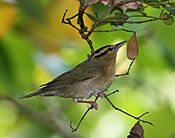 |
Helmitheros Rafinesque, 1819 |
|
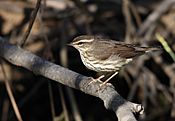 |
Parkesia Sangster, 2008 |
|
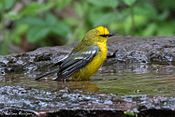 |
Vermivora Swainson, 1827 |
|
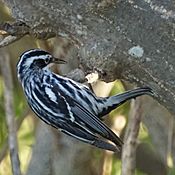 |
Mniotilta Vieillot, 1816 |
|
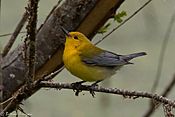 |
Protonotaria Baird, 1858 |
|
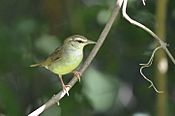 |
Limnothlypis Stone, 1914 |
|
 |
Oreothlypis Ridgway, 1884 |
|
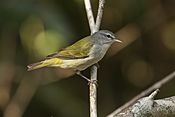 |
Leiothlypis Sangster, 2008 |
|
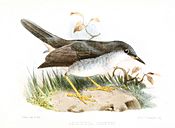 |
Leucopeza Sclater, 1876 |
|
 |
Oporornis Baird, 1858 |
|
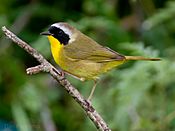 |
Geothlypis Cabanis, 1847 |
|
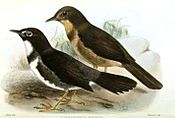 |
Catharopeza P.L. Sclater, 1880 |
|
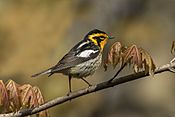 |
Setophaga Swainson, 1827 |
|
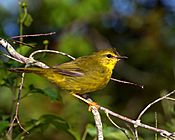 |
Myiothlypis Cabanis, 1850 |
|
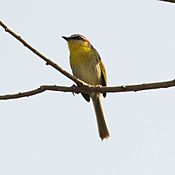 |
Basileuterus Cabanis, 1848 |
|
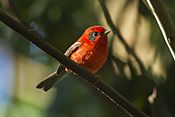 |
Cardellina Bonaparte, 1850 |
|
 |
Myioborus Baird, 1865 |
|
Birds Once Thought to Be Warblers
Some birds that were once considered New World warblers are now placed in different bird families. This happens as scientists learn more about their DNA and relationships. For example:
- The Olive warbler is now in its own family, Peucedramidae.
- The Yellow-breasted chat is also in its own family, Icteriidae.
- Three species in the group Granatellus are now part of the Cardinalidae family (which includes cardinals).
- The Wrenthrush is in its own family, Zeledoniidae.
- Two species from the island of Hispaniola are now in the Phaenicophilidae family.
- Two species from Cuba, in the group Teretistris, are now in their own family, Teretistridae.
What Do New World Warblers Look Like?
All warblers are quite small birds. The smallest is Lucy's warbler, weighing about 6.5 grams (0.23 ounces). It is about 10.6 centimeters (4.2 inches) long. The largest warblers can be over 15 centimeters (5.9 inches) long and weigh more than 21 grams (0.74 ounces). These include the Parkesia waterthrushes, the ovenbird, and Semper's warbler.
Eggs and Chicks
Warblers that migrate long distances tend to lay more eggs, sometimes up to six. This is because their long journeys are risky, and they might only get one chance to have chicks. In contrast, warblers that live in tropical areas and don't migrate usually lay only two eggs. They can give better care to fewer chicks, and they are likely to have more chances to breed over their lives.
Male and Female Appearance
Many warblers that migrate, especially those that breed in the northern parts of their range, have very colorful male birds. This is especially true during the breeding season. Males need bright colors to claim their territory and attract mates each year. This is very noticeable in the large group Setophaga.
However, warblers that live in tropical areas all year round often pair for life. In these species, the male and female birds look very similar. There are some exceptions, though. For example, the Parkesia waterthrushes and the ovenbird are strong migrants, but their males and females look exactly alike. On the other hand, the yellowthroats, which mostly live in tropical areas, have males and females that look different.
See also
 In Spanish: Parúlidos para niños
In Spanish: Parúlidos para niños

